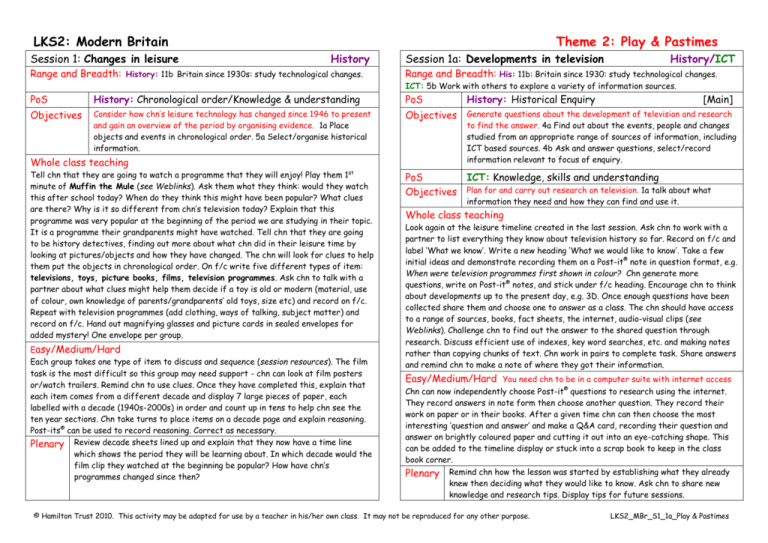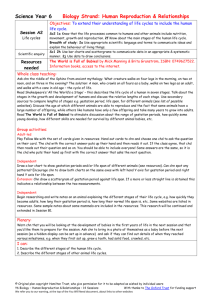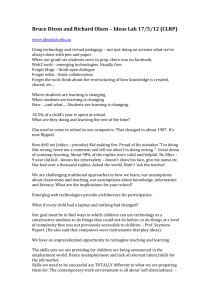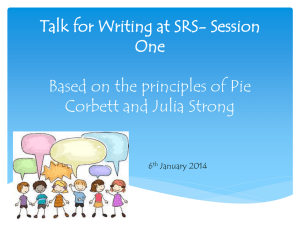Session 01 - Hamilton Trust
advertisement

LKS2: Modern Britain Session 1: Changes in leisure Theme 2: Play & Pastimes History Session 1a: Developments in television History/ICT Range and Breadth: History: 11b Britain since 1930s: study technological changes. Range and Breadth: His: 11b: Britain since 1930: study technological changes. PoS History: Chronological order/Knowledge & understanding PoS Objectives Consider how chn’s leisure technology has changed since 1946 to present and gain an overview of the period by organising evidence. 1a Place objects and events in chronological order. 5a Select/organise historical information. Objectives Generate questions about the development of television and research Whole class teaching Tell chn that they are going to watch a programme that they will enjoy! Play them 1st minute of Muffin the Mule (see Weblinks). Ask them what they think: would they watch this after school today? When do they think this might have been popular? What clues are there? Why is it so different from chn’s television today? Explain that this programme was very popular at the beginning of the period we are studying in their topic. It is a programme their grandparents might have watched. Tell chn that they are going to be history detectives, finding out more about what chn did in their leisure time by looking at pictures/objects and how they have changed. The chn will look for clues to help them put the objects in chronological order. On f/c write five different types of item: televisions, toys, picture books, films, television programmes. Ask chn to talk with a partner about what clues might help them decide if a toy is old or modern (material, use of colour, own knowledge of parents/grandparents’ old toys, size etc) and record on f/c. Repeat with television programmes (add clothing, ways of talking, subject matter) and record on f/c. Hand out magnifying glasses and picture cards in sealed envelopes for added mystery! One envelope per group. Easy/Medium/Hard Each group takes one type of item to discuss and sequence (session resources). The film task is the most difficult so this group may need support - chn can look at film posters or/watch trailers. Remind chn to use clues. Once they have completed this, explain that each item comes from a different decade and display 7 large pieces of paper, each labelled with a decade (1940s-2000s) in order and count up in tens to help chn see the ten year sections. Chn take turns to place items on a decade page and explain reasoning. Post-its® can be used to record reasoning. Correct as necessary. Plenary Review decade sheets lined up and explain that they now have a time line which shows the period they will be learning about. In which decade would the film clip they watched at the beginning be popular? How have chn’s programmes changed since then? ICT: 5b Work with others to explore a variety of information sources. History: Historical Enquiry [Main] to find the answer. 4a Find out about the events, people and changes studied from an appropriate range of sources of information, including ICT based sources. 4b Ask and answer questions, select/record information relevant to focus of enquiry. PoS ICT: Knowledge, skills and understanding Objectives Plan for and carry out research on television. 1a talk about what information they need and how they can find and use it. Whole class teaching Look again at the leisure timeline created in the last session. Ask chn to work with a partner to list everything they know about television history so far. Record on f/c and label ‘What we know’. Write a new heading ‘What we would like to know’. Take a few initial ideas and demonstrate recording them on a Post-it® note in question format, e.g. When were television programmes first shown in colour? Chn generate more questions, write on Post-it® notes, and stick under f/c heading. Encourage chn to think about developments up to the present day, e.g. 3D. Once enough questions have been collected share them and choose one to answer as a class. The chn should have access to a range of sources, books, fact sheets, the internet, audio-visual clips (see Weblinks). Challenge chn to find out the answer to the shared question through research. Discuss efficient use of indexes, key word searches, etc. and making notes rather than copying chunks of text. Chn work in pairs to complete task. Share answers and remind chn to make a note of where they got their information. Easy/Medium/Hard You need chn to be in a computer suite with internet access Chn can now independently choose Post-it® questions to research using the internet. They record answers in note form then choose another question. They record their work on paper or in their books. After a given time chn can then choose the most interesting ‘question and answer’ and make a Q&A card, recording their question and answer on brightly coloured paper and cutting it out into an eye-catching shape. This can be added to the timeline display or stuck into a scrap book to keep in the class book corner. Plenary Remind chn how the lesson was started by establishing what they already knew then deciding what they would like to know. Ask chn to share new knowledge and research tips. Display tips for future sessions. © Hamilton Trust 2010. This activity may be adapted for use by a teacher in his/her own class. It may not be reproduced for any other purpose. LKS2_MBr_S1_1a_Play & Pastimes







